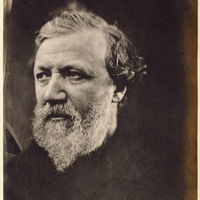Project Presentation and Description
Why did I choose this subject matter and objects for my project?
I studied the history of photography as an undergraduate student and had the opportunity to see some of Julia Margaret Cameron’s works on trips to the J. Paul Getty Museum. Despite being one of the most notable early women photographers, Cameron is neither recognized nor studied nearly as much as she should. I choose the objects seen in my collection for my project, because these are some of her most recognizable images.
Where did I find my images and data?
Images and data collected for this project were gathered from the J. Paul Getty Museum and the Metropolitan Museum of Art. Any descriptions from these institutions are in quotes. Otherwise ,I wrote the descriptions myself based on information I gathered about Cameron.
Resource Template Decisions
Identifier: I used the identifier JMC01-JMC11. The JMC standing for Julia Margaret Cameron and the 01-11 as the number they were given as they were added to the collection. If this collection was expanded on, more numbers can be added to the digits following JMC.
Title: I used the titles given to the photographs by their home institutions, either the Metropolitan Museum of Art of the J. Paul Getty Museum.
Creator: I used the name of the artist for the creator data. In this field, I used the Getty Union List of Artist Names (ULAN) to keep the first name/last name consistent with preferred metadata standards.
Date: In this field, I used the date the photograph was created. If the home institution mentioned a photographic negative and a later print date, I put both of these dates.
Subject: For this field, I described who the work is of or what it is depicting. In many cases, this was who the subject of the portrait was.
Description: The description was a text description of the content of the photograph.
Type: This field describes what kind of art is it and for this collection all of the object types were Photographs.
Medium: This field describes the photographic process employed by Cameron. I used the Getty Art & Architecture (AAT) to correctly locate and define the Medium metadata. Using AAT ensured, I had the preferred term to describe a photographic process.
Format: Format describes the size and dimensions of the object.
Contributor: For this field, I used the museum who has the item in their collection. I included a URI of the object from their website.
Rights: All the works included in the collection are in the public domain.
Controlled Vocabulary Decisions
I used the Getty Union List of Artist Names (ULAN) to keep the Creator metadata and first name/last name consistent with preferred standards.
I used the Getty Art & Architecture (AAT) to correctly locate and define the Medium metadata. Using AAT ensured, I had the preferred term to describe a photographic process.
Walk-through of an Object
This photograph is of the poet Robert Browning.
Where did you get the object and data from?
I got the object from the J. Paul Getty Museum. I got most of the metadata from the Getty Museum object page as well, minus the description field which I pulled from information on other images on the J. Paul Getty Museum’s website or from the Metropolitan Museum of Art’s website.
How does the source metadata differ from your metadata? Did you enrich any of the data?
Although many of the fields are similar between the source and my metadata, my metadata expand upon and standardized some of the original fields. I included background of the portrait’s subject (in this example Robert Browning is an English poet) in the Subject field as well as giving the object a robust Description field. I used the Getty Art & Architecture Thesaurus to standardize the Medium field.
Perspective on the object
I catalog all the objects in this collection as a work of art as opposed to an image, because Julia Margaret Cameron and the home institutions would classify these objects as works of art.
